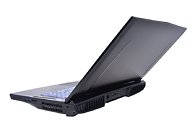Thursday, November 8th 2018
Eurocom Unveils Tornado F7W Mobile Workstation
Eurocom launches another supercomputer class laptop, the Tornado F7 Mobile Workstation powered by 8cores/16threads Intel i9 9900K processor with NVIDIA's high performance Quadro P52000 upgradeable GPU technology.
Eurocom launches the world's most powerful laptop powered by Intel's newest i9 9900K 8 core/16 thread processor and the super-powerful Quadro P5200, called the Tornado F7W. The system comes with a 17.3-inch display, supports up to 128GB of ECC memory, up to 22TB of storage and weighs 4.14kg (9.1 lbs). The Tornado F7W supports a range array of high-performance, modular MXM 3.1, workstation-class GPU's including the Quadro P5200, P4200 and P3200.
The GPU's are upgradeable via MXM 3.1, slot-based GPU technology and the size of each module is 82mm x 105mm. Eurocom offers a wide-choice of processors ranging from i9 9900K, i7 9700K-which are 8-core CPU's, as well as Xeon 6Core/12Thread E-2816G CPUs. These processors are LGA 1151 socket-based, allowing for future upgrades to next-generation processors once they are available.The Tornado F7W comes loaded with security features critical to the management of intellectual property assets of users, companies and organizations. It is equipped with a SmartCard Reader and a Fingerprint scanner for security access as well as TPM 2.0 and BIOS disk encryption for data encryption. These added security features by Eurocom improve the protection of intellectual property assets and restrict access to critical data.
Capable of supporting both ECC and non-ECC memory up to a total 128 GB of DDR4 RAM, the Tornado F7W is one of the very few laptop designs to utilize both ECC and non-ECC memory in the same physical model. ECC memory is used with Xeon-class CPU's while non-ECC memory is used with i7 and i9 processors.
In terms of storage space, the Tornado TFW supports up to 5 physical drives with a total space of 22TB. It supports three M.2 NVMe SSD slots and two 2.5-inch SATA3 bays running in multiple RAID configurations-including RAID 0/1/5/10. It also allows RAID 0/1/5 configuration with NVME SSD's. This feature is also uncommon in most of the high-end laptops in the market today and is one of the many reasons Eurocom laptops stand above the rest, in terms of offering power users extra capabilities they need to perform complex tasks and processes.
When it comes to security, Eurocom offers and optional, "anti-hacking protection suite," consisting of the removal of webcam, microphone and WLAN. This allows for protection of intellectual assets and further defends against malware, tampering and theft of intellectual assets and/or data.
The Tornado F7W is loaded with many ports allowing the usage of 4 total displays. The following ports are also provided: Thunderbolt 3.0, 5 x USB 3.1, HDMI 2.0- just to name a few.
Eurocom supports variety of operating systems in the Tornado F7W including VMware, Microsoft Server 2016, Windows 10 and Linux. Tornado F7W provides full network manageability via its VPro-based Intel I219-LM 1GbE controller on-board - allowing seamless integration into enterprise networks as well as providing remote management and control.
Tornado F7W Core Features:
Eurocom launches the world's most powerful laptop powered by Intel's newest i9 9900K 8 core/16 thread processor and the super-powerful Quadro P5200, called the Tornado F7W. The system comes with a 17.3-inch display, supports up to 128GB of ECC memory, up to 22TB of storage and weighs 4.14kg (9.1 lbs). The Tornado F7W supports a range array of high-performance, modular MXM 3.1, workstation-class GPU's including the Quadro P5200, P4200 and P3200.
The GPU's are upgradeable via MXM 3.1, slot-based GPU technology and the size of each module is 82mm x 105mm. Eurocom offers a wide-choice of processors ranging from i9 9900K, i7 9700K-which are 8-core CPU's, as well as Xeon 6Core/12Thread E-2816G CPUs. These processors are LGA 1151 socket-based, allowing for future upgrades to next-generation processors once they are available.The Tornado F7W comes loaded with security features critical to the management of intellectual property assets of users, companies and organizations. It is equipped with a SmartCard Reader and a Fingerprint scanner for security access as well as TPM 2.0 and BIOS disk encryption for data encryption. These added security features by Eurocom improve the protection of intellectual property assets and restrict access to critical data.
Capable of supporting both ECC and non-ECC memory up to a total 128 GB of DDR4 RAM, the Tornado F7W is one of the very few laptop designs to utilize both ECC and non-ECC memory in the same physical model. ECC memory is used with Xeon-class CPU's while non-ECC memory is used with i7 and i9 processors.
In terms of storage space, the Tornado TFW supports up to 5 physical drives with a total space of 22TB. It supports three M.2 NVMe SSD slots and two 2.5-inch SATA3 bays running in multiple RAID configurations-including RAID 0/1/5/10. It also allows RAID 0/1/5 configuration with NVME SSD's. This feature is also uncommon in most of the high-end laptops in the market today and is one of the many reasons Eurocom laptops stand above the rest, in terms of offering power users extra capabilities they need to perform complex tasks and processes.
When it comes to security, Eurocom offers and optional, "anti-hacking protection suite," consisting of the removal of webcam, microphone and WLAN. This allows for protection of intellectual assets and further defends against malware, tampering and theft of intellectual assets and/or data.
The Tornado F7W is loaded with many ports allowing the usage of 4 total displays. The following ports are also provided: Thunderbolt 3.0, 5 x USB 3.1, HDMI 2.0- just to name a few.
Eurocom supports variety of operating systems in the Tornado F7W including VMware, Microsoft Server 2016, Windows 10 and Linux. Tornado F7W provides full network manageability via its VPro-based Intel I219-LM 1GbE controller on-board - allowing seamless integration into enterprise networks as well as providing remote management and control.
Tornado F7W Core Features:
- Display: 17.3 inch/43.9 cm; choice of FHD, UHD 4K; 120Hz, 60Hz; supports total 4 displays
- GPU: MXM 3.1, upgradeable, choice of NVIDIA Quadro P3200 (6GB); P4200 (8GB) and P5200 (16GB)
- CPUs: Choice of LGA1151 CPUs; 6 cores/12 threads- (Xeon E-2176G, Xeon E-2186G, i7 8700, i7 8700K, i7 8086K); 8 cores/8 threads- (i7 9700K); 8 cores/16 threads - (i9 9900K)
- Memory: up to 128GB via four SODIMM slots; EEC and non-ECC depending on CPU used.
- Storage: up to 5 physical drives with RAID 0/1/5, NVME, up to 22TB of storage; three M.2 NVMe SSD and two 2.5inch SATA3
- Operating Systems: choice of VMWare, Microsoft Server 2016, Windows 10 and Linux
- Security: SmartCard Reader, TPM 2.0, BIOS Disk Encryption, Security lock, Fingerprint scanner; optional "anti-hacking package" available (removal of webcam, microphone and WLAN)
- Ports: 1x Thunderbolt 3.0; 5x USB 3.1; Mini Display; HDMI 2.0; Mic in; Headphone S/PDIF out; Line-in; Line out; RJ-45 / LAN





17 Comments on Eurocom Unveils Tornado F7W Mobile Workstation
Not that it's likely to matter too much for anyone buying this thing, but still, it's a "mobile" workstation...
This is like the best laptop specs I’ve ever seen
If you want it above the keyboard (like in my M4800), that either cuts into mobo space, or forces you to flip the mobo over so that the main component area is sandwiched between the keyboard and mobo, rather than between the mobo and bottom panel.
Sure, where the motherboard is and how it's shapred are design choices, but there is no option that lets you get everything. There's always a tradeoff, and for this machine, they chose to have bottom-firing speakers in order to have more accessible components and better thermal design (shorter heatpipes and double fan/heatsink exhaust). On my M4800, they put the speakers above the keyboard, but in order to do that, CPU, GPU, mobo and heatsink access are only possible after removing the keyboard and palmrest, a somewhat annoying 15minute endeavour. At least with my M4800 I get a much tougher chassis in exchange...If you're listening to audio in a laptop, odds are you're indeed listening using headphones, and/or better external speakers. Built-in speakers then become the last resort.
Also, audio isn't just for gaming or media consumption. Video editing? Animation and voice dubbing? Other media production involving audio? Of course we won't get studio monitor-quality speakers in there, but having "not-crap" audio is really a minimum requirement for something like this.
Also, what you're saying about the layout is not true. I/O can (ought to? makes for better repairability) be moved to daughterboards connected with flex cables. This would likely make the motherboard cheaper to manufacture, and would allow for more freedom in shaping the motherboard and placing components. You're right that the top doesn't make sense for speakers (there's room in the centre, but that kills stereo separation, and squeezing it above the heatpipes seems impractical, although it could be done with drivers mounted centrally and resonance chambers leading the sound to the sides), but with a laptop this thick there should be zero problem sandwiching a resonance chamber between the side I/O and the keyboard surround, with the speaker placed slightly off to the side. And a laptop speaker like the two we see here is not thick - a few mm including its casing, unless they're using something extra beefy. And even if they were thick, careful placement and a well-designed resonance chamber leading to outlets next to the keyboard would make this no problem at all. Look at the 15" MBP - the speaker drivers are significantly removed from where the audio exits the resonance chamber. And I'm willing to bet that small thin-and-light 15" sounds far superior to this 17" monstrosity.
These days the only laptops getting updates are 15 and 17" laptops. I want another W110ER! An 11.6" gaming laptop using a ryzen 2700u, or something weird and different.
I'd never ever buy a Eurocom product. They have horrible customer service and are generally just annoying to deal with
Also to anyone actually interested, this is just a MSI Titan rebranded. Eurocom does not produce any of their own laptops, they are all shells from Clevo or MSI
This isn't even their flagship product, thats the P870TM1
As a sidenote, the whole speaker + resonance chamber assembly of my phone is about 4mm thick. The one in my laptop is even thicker. On that note, have you considered that they are using resonance techniques extensively already? Both of those speaker and that "subwoofer" have resonance chambers behind em, and being bottom-mounted, will take advantage of hard surfaces to reflect sounds upwards to the listener.
PS: resonance chambers are primarily used to improve sound quality of the speakers (particularly bass response), not to make them fit a chassis. The fact it lets you mount your driver away from the sound outlet is just a side benefit, really.
Tl;dr: they really could have made more of an effort on this. That's really all I'm saying.